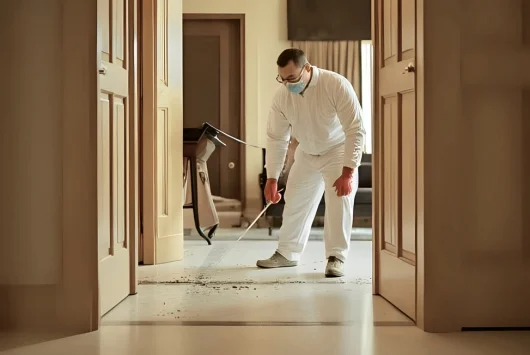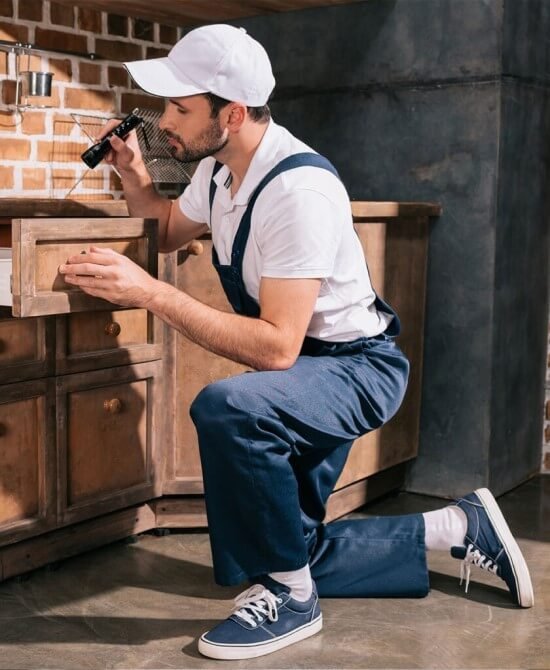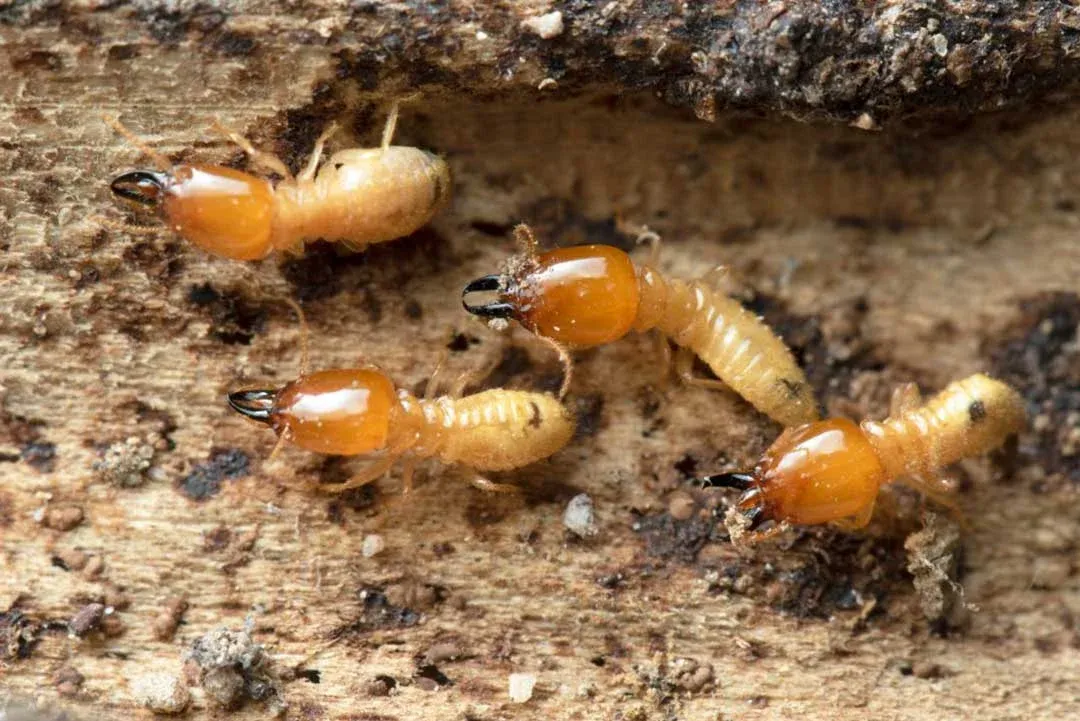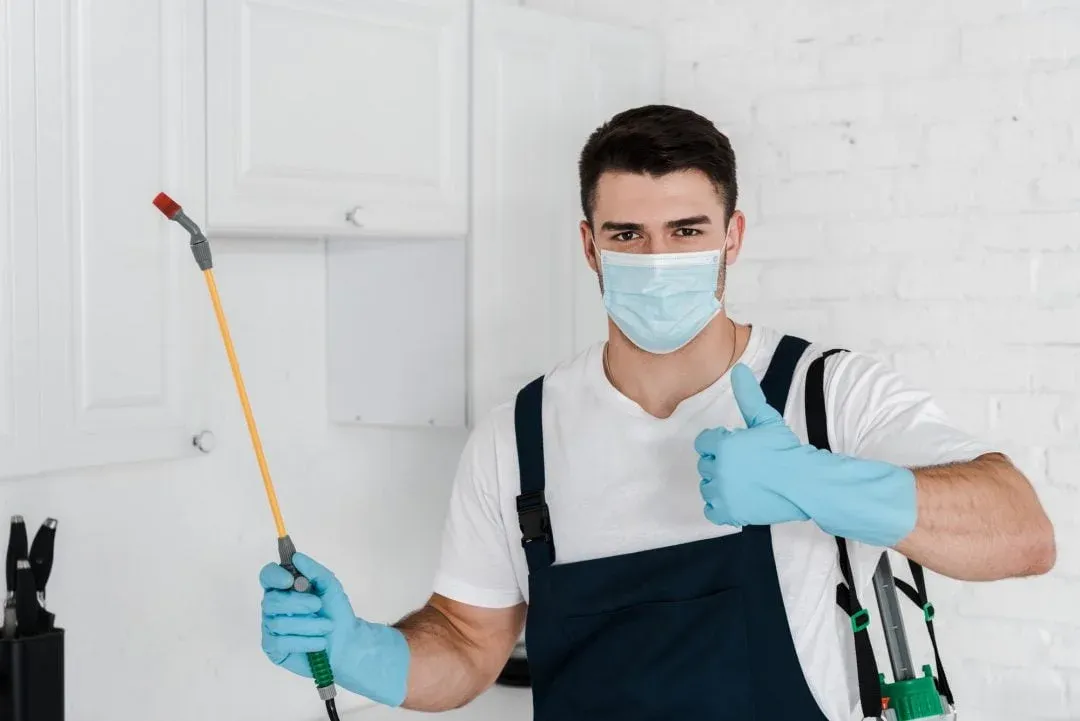- Tulip Al Barsha, Office G02, Barsha Rd, Al Barsha 1, Dubai – United Arab Emirates
- +971 56 369 0115
Termites silently destroying your property’s structure? At UAE Pest Control, we provide comprehensive termite elimination and prevention using advanced treatment methods that protect your investment. With same-day emergency service across Dubai, Ajman, and Sharjah, our certified termite specialists stop structural damage before it costs you thousands in repairs.
✓ Complete termite colony elimination
✓ Pre & post-construction protection
✓ Long-term structural warranties
Don’t let termites undermine your property value—book your termite control service today!
Termites represent one of the most destructive pests affecting Dubai properties, causing millions of dirhams in structural damage annually. Unlike most pests creating obvious problems, termites work silently within walls, foundations, and wooden structures for years before visible damage appears. By the time homeowners discover termite infestations, extensive structural damage often exists requiring costly repairs beyond pest control expenses.
Financial Impact: Termite damage typically isn’t covered by standard property insurance policies, making prevention and early intervention essential for protecting your investment. A severe termite infestation can reduce property values by 20-30% and cost tens of thousands of dirhams in structural repairs.
Dubai’s climate provides ideal conditions for termite activity year-round. Warm temperatures accelerate termite colony growth and foraging activity, while high humidity in coastal areas creates moisture conditions termites require. The combination of modern construction methods using wood framing, extensive landscaping with irrigation providing moisture, and climate-controlled buildings offering comfortable temperatures makes UAE properties particularly vulnerable to termite attack.
Subterranean termites, the primary species affecting Dubai, live in underground colonies housing hundreds of thousands to millions of individuals. These colonies extend 50-100 meters from central nests, with foraging termites searching constantly for cellulose food sources. A single colony can consume 5-7 kilograms of wood annually, progressively weakening structural components until catastrophic failure occurs.
New construction faces immediate termite risks without proper pre-treatment. Termites can establish colonies during building phases, infiltrating structures before completion. Post-construction treatments prove more difficult and expensive than preventive pre-construction applications, making termite protection essential during building phases.
Established properties require vigilant monitoring and preventive treatments. Termites enter through foundation cracks as small as 1mm, travel through utility conduits, and access wooden structures through mud shelter tubes allowing them to cross concrete and masonry. Regular inspections detect early termite activity before major damage occurs, protecting property values and structural integrity.
Commercial properties face amplified termite risks due to size, complexity, and operational requirements that can mask early warning signs. Hotels, restaurants, offices, and warehouses all experience termite problems that threaten business operations, create legal liabilities, and undermine property values. Professional termite management programs protect commercial investments while ensuring compliance with maintenance standards.
Our termite specialists provide complete protection using integrated treatment approaches combining liquid barrier treatments, baiting systems, wood treatments, and monitoring. We address both existing infestations and future prevention, offering long-term warranties protecting your investment.
Complete Home Treatment: Comprehensive termite elimination for existing infestations using liquid termiticides applied around entire property perimeters, beneath slabs through injection, within wall voids where termites travel, and around all potential entry points. Treatments create continuous chemical barriers preventing termite access while eliminating active colonies.
Pre-Construction Termite Protection: Essential treatments for new construction applying termiticides to foundation areas before concrete pouring, treating all wood framing components, creating chemical barriers around utility penetrations, and documenting treatments meeting building code requirements. This preventive approach provides decades of protection when properly applied.
Post-Construction Treatment: Barrier treatments for completed buildings using exterior perimeter applications, interior void treatments, and targeted wood treatments. More complex than pre-construction but equally effective when comprehensive protocols followed.
Baiting System Installation: Advanced termite bait stations placed strategically around property perimeters. Stations contain monitoring devices detecting termite activity, then deploy termiticide baits that workers carry back to colonies, eliminating entire populations including queens. Ideal for properties where liquid treatments prove impractical.
Wood Treatment and Protection: Direct application of termiticides and wood preservatives to exposed wooden structures, furniture, and decorative elements preventing termite attack. Particularly important for valuable antique furniture and irreplaceable wood components.


Office Building Protection: Comprehensive programs for commercial towers and business parks including perimeter barrier treatments, interior void applications, parking structure protection, and regular monitoring ensuring tenant spaces remain termite-free.
Hospitality Industry Solutions: Hotel and resort termite management protecting guest rooms, public spaces, restaurants, and landscaped areas. Discreet treatments maintaining operational schedules while ensuring complete structural protection.
Retail and Supermarket Services: Termite prevention for commercial spaces where structural damage threatens business operations and inventory. Focus on stockrooms, display areas, and building perimeters preventing termite infiltration.
Warehouse and Industrial Facilities: Large-scale termite control for storage and manufacturing facilities using exterior bait station arrays, comprehensive barrier treatments, and interior monitoring systems protecting valuable inventory and equipment.
Restaurant and Food Service: Critical termite protection for establishments where structural integrity affects health licensing and operational safety. Regular inspections and preventive treatments prevent closures from termite-related damage.
Pre-Purchase Termite Inspections: Comprehensive property evaluations for buyers assessing termite activity, existing damage, and treatment history. Detailed reports inform purchase decisions and negotiate repairs before property transfer.
Annual Monitoring Programs: Ongoing protection through regular inspections, bait station monitoring, early detection systems, and immediate treatment if activity detected. Provides peace of mind and long-term protection.
Emergency Termite Treatment: Rapid response for severe active infestations threatening structural integrity. Immediate assessment followed by aggressive treatment protocols stabilizing damage and eliminating colonies quickly.
Furniture and Content Treatment: Specialized services for treating termite-infested furniture, antiques, books, and other valuable items using heat chambers, fumigation, or spot treatments saving items from disposal.

Understanding termite social organization explains why complete colony elimination requires professional expertise. Colonies begin when winged reproductive termites swarm, typically during spring and early summer in Dubai. After brief flights, they shed wings, pair, and establish new colonies. These founding pairs become kings and queens, with queens eventually producing thousands of eggs annually maintaining colony growth.
Worker termites perform all colony maintenance including foraging, feeding other castes, brood care, and nest construction. They represent 90-97% of colony populations and cause all structural damage. Workers cannot reproduce but live 1-2 years, continuously replaced by queen egg production.
Soldier termites defend colonies against predators, primarily ants. Their enlarged heads and powerful mandibles make them formidable defenders but prevent them from feeding themselves—workers must provide nutrition. Soldiers represent 2-5% of colony populations.
Colonies grow slowly initially, taking 3-5 years to reach economically significant sizes. However, mature colonies persist decades, continuously expanding and causing progressive damage. Queens can live 25+ years, producing millions of offspring maintaining vast underground empires.
Subterranean Termites cause the vast majority of termite damage in Dubai. These termites nest underground, often near building foundations, extending foraging tunnels throughout surrounding soil. Colonies contain three distinct castes: reproductive kings and queens, soldier termites defending colonies, and worker termites conducting all foraging, feeding, and damage.
Worker termites, pale-bodied and soft, venture from colonies seeking cellulose sources. They cannot tolerate open air or sunlight, building distinctive mud shelter tubes over concrete, masonry, and metal surfaces to access wooden structures while maintaining protected humid environments. These tubes, roughly pencil-width, represent the most obvious sign of active termite infestation.
Drywood Termites infest Dubai properties less commonly than subterranean species but create distinct problems. Unlike subterranean termites requiring soil contact, drywood termites live entirely within wood they consume. Infestations occur in furniture, roof timbers, window frames, and other wooden components. Their presence becomes apparent through small piles of wood-colored pellets pushed from galleries as they tunnel through wood.
Dampwood Termites occasionally affect Dubai properties, particularly in areas with moisture problems. These large termites require high wood moisture content, infesting water-damaged timbers, leaking structures, and landscape wood in contact with soil. Addressing moisture issues typically eliminates dampwood termite problems without extensive treatment.
Early termite detection prevents extensive damage. Warning signs include mud shelter tubes on foundations, walls, and other surfaces, discarded wings near windows and doors after swarming events, hollow-sounding wood when tapped, visible wood damage including tunneling and honeycomb patterns, stuck doors or windows from termite damage warping frames, and small piles of wood-colored pellets indicating drywood termite activity.
Subterranean termite damage typically remains hidden within wood, with surface wood shells maintained while interiors are consumed. This makes damage difficult to detect without professional inspection using specialized tools.
Termites thrive where moisture, wood-to-soil contact, and warm temperatures coincide. Dubai properties create these conditions through improper drainage allowing water accumulation near foundations, landscaping mulch contacting building exteriors, wood fence posts and deck supports buried in soil, firewood storage against building walls, irrigation systems overwatering near structures, and plumbing leaks creating moisture in walls and beneath slabs.
Addressing these environmental factors reduces termite attraction and supports professional treatment effectiveness.
Effective termite control begins with comprehensive inspections by certified technicians using specialized detection equipment. Our inspectors examine all accessible areas including foundations and crawl spaces, interior walls and floors, attic spaces and roof timbers, exterior grounds and landscaping, outbuildings and fences, and moisture-prone areas like bathrooms and kitchens.
Advanced detection tools include moisture meters identifying high-risk areas, thermal imaging cameras detecting termite activity through temperature variations, acoustic sensors hearing termite feeding sounds within walls, and borescopes examining wall voids and difficult-access areas without destructive opening.
Detailed inspection reports document all findings with photography, identify termite species present, assess infestation severity and structural damage extent, mark treatment zones on property diagrams, and provide detailed treatment recommendations with cost estimates and warranty information.
Liquid Termiticide Barrier Treatments: The most common and effective termite control method involves applying liquid termiticides creating continuous chemical barriers around building perimeters and beneath slabs. Modern non-repellent termiticides allow termites to contact treated soil, carrying active ingredients back to colonies before effects occur, eliminating entire populations including queens.
Treatment process includes trenching around building perimeters to foundation depth, injecting termiticide into trenches at specified rates, drilling through slabs or foundations accessing soil beneath buildings, injecting termiticide beneath slabs creating comprehensive barriers, treating wall voids where termites travel between levels, and treating around all utility penetrations preventing access routes.
Proper liquid treatments require 200-400 liters of mixed termiticide for average homes, applied at depths ensuring complete barrier formation. Treatments remain effective 5-10 years depending on soil conditions, products used, and environmental factors.
Termite Baiting Systems: Above-ground and in-ground bait stations offer alternative or supplementary termite control. Stations placed at 3-meter intervals around property perimeters contain monitoring devices attracting foraging termites. Once activity detected, technicians replace monitors with bait containing slow-acting termiticides or insect growth regulators.
Worker termites consume bait and share with colony members through normal feeding behaviors, distributing active ingredients throughout colonies including queens. This eliminates colonies without extensive chemical applications around structures. Baiting proves particularly effective where liquid treatments prove impractical due to concrete coverage, indoor treatments being undesirable, or environmental concerns about soil treatment.
Wood Treatment Applications: Direct treatment of wooden structures using termiticides and wood preservatives protects against attack. Surface applications penetrate wood surfaces killing termites on contact and providing residual protection. Injectable treatments for infested wood use specialized equipment forcing termiticides deep into galleries, eliminating active infestations.
Fumigation Services: Whole-structure fumigation eliminates drywood termite infestations throughout buildings. This treatment involves sealing buildings under gas-proof tarps, introducing fumigants that penetrate all wood killing termites at all life stages, maintaining fumigant concentrations for 24-72 hours, and aerating structures before reoccupancy. Fumigation provides complete drywood termite elimination but requires temporary relocation and offers no residual protection.
Preventive Wood Treatment: Pre-construction wood treatment using borate-based products provides long-term protection for framing lumber, preventing termite attack even if chemical barriers fail. This belt-and-suspenders approach offers superior protection for new construction


Comprehensive termite control combines multiple approaches for maximum effectiveness. Our integrated programs include chemical barrier treatments eliminating existing colonies, bait station installations providing ongoing monitoring and control, structural modifications reducing termite attraction, moisture management addressing conditions supporting termites, regular inspections detecting new activity before damage occurs, and detailed record-keeping documenting all treatments and findings.
Specialized training in termite biology, identification, and treatment methods. Our technicians hold certifications from international pest management organizations demonstrating expertise.
Professional-grade termiticides, baiting systems, application equipment, and detection tools deliver superior results unavailable through general pest control services.
Long-term structural warranties covering termite damage and retreatment if termites return. Our warranties transfer to new property owners, protecting resale values.
Specialized pre-construction treatment services meeting UAE building code requirements. Complete documentation provided for building inspections and future reference.
We inspect structural damage extent, provide detailed repair recommendations, coordinate with contractors for structural repairs, and document all work for insurance and warranty purposes.
Full licensing and regulatory compliance ensuring all treatments meet UAE safety and efficacy standards.
Termite prevention starts with moisture management. Fix all plumbing leaks immediately, ensure proper drainage around foundations sloping away from buildings, repair air conditioning condensate issues, maintain gutters and downspouts, eliminate standing water around properties, and address any roof leaks promptly.
Proper landscaping reduces termite attraction. Keep mulch and soil at least 30cm from building foundations, avoid wood-to-soil contact by elevating fence posts and deck supports, remove stumps, buried wood, and landscape debris, store firewood elevated and away from structures, trim vegetation away from buildings improving air circulation, and adjust irrigation preventing overwatering near foundations.
Regular property maintenance reduces termite risks. Seal cracks in foundations and exterior walls, ensure proper ventilation in crawl spaces and attics reducing moisture accumulation, repair damaged wood promptly, maintain weather stripping and door seals, and address any water damage immediately before it attracts termites.
Annual professional termite inspections detect activity before major damage occurs. Many termite treatment warranties require regular inspections maintaining coverage. Early detection allows simpler, less expensive treatments compared to waiting until obvious damage appears.
Modern termiticides demonstrate excellent safety profiles when properly applied by licensed professionals. Products used in termite control undergo extensive testing ensuring minimal risks to humans, pets, and the environment when label directions followed.
Liquid termiticide applications occur outside living spaces in soil around foundations and beneath slabs, minimizing exposure. Interior treatments in wall voids use minimal amounts in contained spaces. Proper application techniques and curing times ensure safety for occupants.
Termite bait systems use minimal active ingredients placed in tamper-resistant stations, providing excellent safety profiles suitable for properties with children and pets, schools, healthcare facilities, and environmentally-sensitive areas.


During treatments, we implement safety protocols including clearly marking treatment areas, preventing access to application zones during treatments, providing safety data sheets for all products used, following all manufacturer label directions, and ensuring proper ventilation and curing times before reoccupancy.
Fumigation treatments require temporary evacuation, typically 24-72 hours depending on structure size and fumigant used. Professional aeration and safety testing confirm safe reentry before occupants return.
Your termite protection journey begins with detailed phone consultation discussing property type, construction age, previous termite history, and concerns about current activity. We schedule comprehensive inspections at convenient times and provide preliminary advice about minimizing termite risks.
Certified termite inspectors conduct thorough property evaluations typically requiring 1-2 hours depending on property size and accessibility. Inspection includes complete exterior examination of foundations, landscaping, and potential entry points, interior assessment of floors, walls, and accessible structural components, attic and crawl space inspection when accessible, examination of outbuildings, fences, and landscape features, moisture assessment identifying high-risk areas, and documentation of any active termite presence or previous damage.
We use specialized inspection tools including moisture meters, thermal cameras, and acoustic detectors revealing termite activity invisible to visual inspection alone. Detailed findings reports with photography explain termite species if present, evidence of current or previous activity, structural damage assessment and repair needs, conducive conditions attracting termites, and detailed treatment recommendations with pricing and warranty information.
For pre-purchase inspections, reports meet real estate transaction requirements, providing buyers with comprehensive termite status assessments informing purchase decisions and negotiations.
Based on inspection findings, we develop customized treatment plans explaining recommended approaches, treatment process and timelines, preparation requirements, product information and safety data, and warranty coverage details.
Pre-treatment preparation varies by treatment type. Liquid barrier treatments require clearing areas around foundations providing access, removing stored items from treatment zones, ensuring pets and children remain away during application, and providing access to interior areas if void treatments needed.
Baiting system installations require minimal preparation, primarily ensuring clear access to installation locations around property perimeters.
Fumigation treatments require extensive preparation including removing all people, pets, and plants, sealing or removing medications and food items per instructions, disconnecting gas lines and extinguishing pilot lights, and arranging temporary accommodations during treatment and aeration periods.
Liquid Barrier Treatment Process: Our crews arrive with specialized equipment including trenching tools, high-volume injection pumps, and calculated amounts of termiticide. Treatment typically requires 4-8 hours for residential properties depending on size and complexity.
Process includes trenching around entire building perimeter to foundation depth (typically 30cm deep and 15cm wide), applying termiticide to trenches at manufacturer-specified rates, drilling through slabs accessing soil beneath at 30cm intervals, injecting termiticide beneath slabs creating continuous barriers, treating wall voids if termite activity detected in upper levels, and treating around all plumbing and utility penetrations.
All holes drilled through slabs or foundations are properly patched with concrete or appropriate materials. Treatment zones are clearly marked and documented for future reference.
Baiting System Installation: Stations installed at 3-meter intervals around property perimeters by digging small holes, installing bait stations flush with ground level, loading monitoring devices, documenting station locations with GPS coordinates, and establishing monitoring schedules for regular checking.
Initial monitoring occurs monthly until termite activity detected, then service intervals intensify to weekly during active baiting phases. Once colonies eliminate, monitoring returns to quarterly schedules maintaining long-term protection.
Fumigation Process: Preparation inspection ensures proper preparation completion. Structure tarping using specialized gas-proof materials creates sealed environment. Fumigant introduction through carefully calculated amounts based on structure cubic volume. Concentration monitoring throughout fumigation period ensures lethal levels maintained. Aeration using fans and opening after minimum exposure times. Air quality testing confirming safe reentry levels before removing tarps and clearing property for occupancy.
Detailed post-treatment instructions ensure warranty compliance and optimal protection. For liquid treatments, avoid disturbing treated soil around foundations, maintain exclusion work we’ve performed, address any moisture problems promptly, schedule annual inspections maintaining warranty coverage, and report any signs of termite activity immediately.
Baiting systems require regular monitoring by our technicians. We handle all station checking and bait replacement—property owners should not disturb stations.
Documentation provided includes detailed treatment records with products used, application rates, and treated areas, warranty certificates with coverage terms and conditions, maintenance requirements for warranty validity, and emergency contact information for questions or concerns.
Most treatment warranties include annual inspections verifying continued termite-free conditions, checking treatment integrity, monitoring for new termite pressure, and providing additional treatments if needed under warranty coverage. These inspections maintain your protection and are typically included in warranty packages.


More than 75 trained & certified professionals